Eric's Germany Journal, Köln
Wednesday, May 28, 2003
I dithered a lot about whether to take my notebook computer on this trip.
It adds a lot of weight and bulk to my luggage, and packing up the
necessary power and phone adapters is a nuisance. However, I only have to
move it three times (Ulm to Bruxelles, Bruxelles to London, and London to
Ulm); it will let me process pictures from the camera and make room for
more during the trip, write about the trip each day, and check my email;
and the PocketPC has become unreliable. So I took it.
The train transfer in Mannheim went okay. The first train stopped outside
Mannheim, so I started getting worried about catching the second train.
We pulled into the station with less than two minutes to spare, and I
hopped onto the train to Köln.
Köln
Köln
is an active city—things are happening; people are moving
purposefully, giving a "things to do, places to be" impression; traffic
is urgent. That is the first German city I have seen that gives the
impression of that kind of activity. There was a lot of activity in
Heidelberg, but it felt more recreational or social, whereas
Köln's activity feels like business.
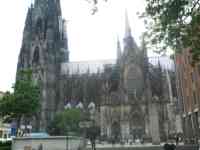 |
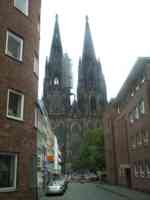 |
| Kölner Dom. |
Adjacent to the Hauptbahnhof is the Dom, a cathedral started in 1248,
worked on for 300 years and left half-finished for 300 years. They found the
original architectural plans in 1820 and restarted contruction, which finished
in 1880. Personally, I would be a bit reluctant to use 600-year-old
architectural plans. (Hmm, I should have thought about that before I went
inside.) It is big and open inside.
The Dom is 157 meters high. (Ha! Ulm's Münster wins at 161.6 meters.)
There are 509 steps to its viewing platform at 95 meters. (The Münster
has 768 steps to the platform at 143 meters.)
The Dom is a Unesco World Heritage Site, which I think means
we are supposed to not bomb it the next time Germany is bad. (Köln is
almost 2000 years old but was almost completely destroyed in World War II.)
South of the Dom is Köln's shopping area. Hohe Straße could be
a shopping street in any large city—it is packed with characterless
stores, the buildings are adjacent to each other, and there is little to
express the city or country it is in. There was one store selling "original"
eau de Cologne. I walked straight through the shopping district,
east to the Rhein, and south to the island with the
Imhoff Stollwerck
Museum.
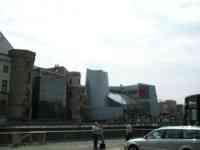 |
| Imhoff Stollwerck (Chocolate) Museum. |
Stollwerck is a chocolate company, and their museum is a large chocolate
museum. It has three floors, 4000 square meters, a tropical greenhouse,
working chocolate production, and a chocolate fountain. Most of the
exhibits include English.
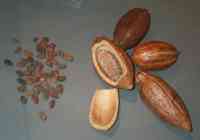 |
| Cacao pods and beans. |
One exhibit says the Theobroma Cacao tree is related to the hibiscus
and the kola trees. It also says the growth of flowers on its trunk is
a "unique attribute" that is "shared by various other tropical plants," so
I guess it is only a little bit unique.
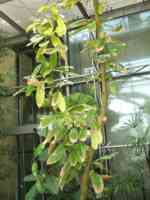 |
| Theobroma Cacao, a chocolate tree. |
The glass-paneled building you see in the picture of the museum above is
the greenhouse, and the chocolate tree shown to the right is inside it.
It is very, very warm in there, and they have other tropical
plants growing, like the banana tree below.
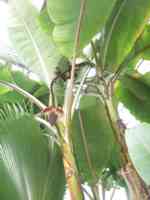 |
| Banana tree. |
Eighty to ninety percent of the world cacao harvest is Forastero, with
a yellow thick-skinned fruit. About ten percent is Criollo, considered a
finer chocolate, that is tangy and aromatic with a yellow or reddish-brown
fruit. There is a natural hybrid called Trinitario.
Additional displays report the economic situations of some small farmers of
chocolate and of chocolate workers, which is not all good. I was wondering if
that information would be there, considering it is the museum of a chocolate
manufacturer. Stollwerck deserves credit for being open about the problems.
 |
| Cocoa Butter Press. |
The cocoa butter press to the right was built in 1899.
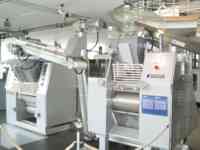 |
| Machines making chocolate. |
The museum also has modern equipment making chocolate while you watch.
The machines to the left grind chocolate to particles smaller than
.02 millimeters and are cooled to prevent the chocolate from liquefying
as the friction of griding heats it. The room this machine is in smells
very good.
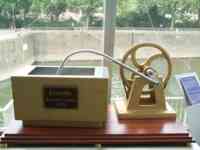 |
| Reproduction of Rodolphe Lindt's 1879 conche machine. |
The most important machine historically for chocolate is the conche machine,
which makes chocolate smooth and better tasting. Rodolphe Lindt built the
first conche machine in 1879.
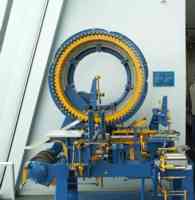 |
| Toblerone-wrapping machine. |
It stirs, heats, and aerates chocolate to remove
bitter substances and homogenize the chocolate, giving it the
flavor and smoothness we know today.
The machine to the right wrapped Toblerone bars in 1948.
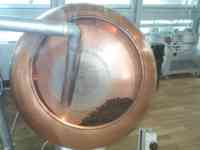 |
| Chocolate-coating machine. |
On the left is a machine making chocolate-coated candies. The machine rotates
to constantly stir candies to make the coating even. The pipe blows in cold
air to cool one layer of chocolate, and more layers are added to get the
desired thickness. I do not know why the entire inside of the ball does not end
up coated with chocolate.
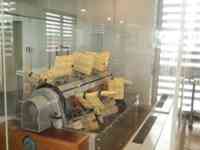 |
| Machine making truffle shells. |
The machine to the right makes truffle shells. Each yellow case contains
many spherical molds and has two parts. Chocolate paste is poured into
the bottom half of each mold, and then the top part of the case is
attached. This machine turns the cases in all directions to coat the
inside of the mold evenly with chocolate while it slowly cools. When
the chocolate shell is hard, the truffle filling is injected into it.
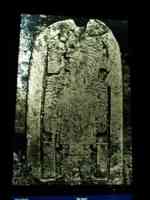 |
| Mr. Cocoa. |
The guy depicted in stone to the left was known as Mr. Cocoa, a prestigious
name since cocoa was so important. He ruled in Tikal from 682 to 744.
(They did not actually call him "Mr. Cocoa." That is a translation based on
the fact that the glyph used for his name resembles the cocoa bean.)
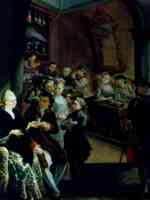 |
| Chocolate bar. |
On the right is a painting of people drinking chocolate in a bar.
It was painted around 1740.
Other exhibits in the museum show serving utensils and accessories for
chocolate, from old wooden spoons to ornate silver cups; discuss harvesting
techniques, production techniques, and equipment; and relate the history,
politics, and colonialism associated with chocolate.
 |
| Cacao beans from different locations. |
There are many varieties of cacao beans. The case to the left contains
beans from different places around the world. Actually, around the equator,
since chocolate grows in tropical locations.
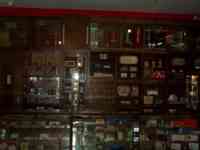 |
| Reproduction of an old chocolate store. |
To the right is a reproduction of an old chocolate store.
Part of the top floor of the museum discusses the use of chocolate in,
as, or with medicine. It was not just used to make medicine taste better.
Manufacturers claimed chocolate had various medicinal qualities and won
court approval in Germany to make such claims. Chocolate was also a good
delivery method for medicine because it melts at body temperature.
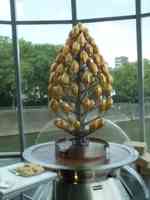 |
| Chocolate fountain. |
Near the end of the tour through the museum (if you go through in the
correct order, which I did not) is a chocolate fountain.
It looks better in the photograph than in real life. The fountain is a
nice attempt, with gold-foil cacao pods arranged in the shape of a larger
pod, but the chocolate glops instead of flowing smoothly.
That finished the museum, and of course I visited the store, but the
chocolates they had are mostly unremarkable. Most of the store is filled
with packaged mass market chocolates, and there is little in the way of
chocolate souvenirs. There is a display case with some nicer chocolates,
but nothing I would go out of my way for.
 |
| The Rhein in Köln. |
Near the chocolate museum is this view of the Rhein.
After leaving the museum, I went to the Hard Rock Cafe. My friend
Cathleen is collecting shot glasses from Hard Rock Cafes in different
cities. (Each glass is labeled with the city.) She is going to have a
good collection when I am done in Europe.
 |
| Ice cream cone. |
I spent the rest of my time in Köln wandering around the shopping
district, its outskirts, and the Altstadt. This ice cream cone is
quite noticeable, but I did not see what it had to do with the department
store underneath it.
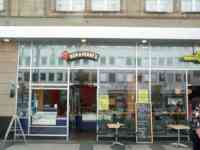 |
| Ben and Jerry's. |
It was nowhere near the good ice cream store on the right.
There were a lot of beggars in Köln, near the Dom and in the shopping
district. They appeared to be mostly Indian or of similar ethnicity.
Germany is generous compared to other countries in allowing refugees to come,
but I do not know if recent immigrations produced this situation in
Köln or it is older.
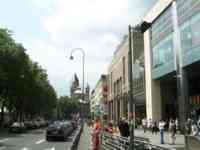 |
| A street in Köln. |
To the right is a street at the south end of the shopping district,
again showing the mix of new and old in Germany.
I headed back to the train station and noticed how open it seems. The
structure is very airy, and you can walk directly to the first platform
from the general city without going through the train station itself.
 |
 |
| Köln Hauptbahnhof. |
Pigeon stairs. |
The street by the train station is lower than the Dom and the shopping
district, and one of the staircases between them looks like it has been
closed for a long time. The pigeons have taken it over completely.
I went into the station and waited for my train to Bruxelles.
© Copyright 2003 by
Eric Postpischil.
























